| Hallucinogenic Mushrooms |
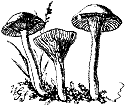 |
| Hallucinogenic Mushrooms |
 |
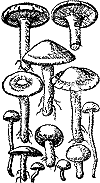 |
What are Hallucinogenic Mushrooms?Mushrooms, a kind of fungus, come in many varieties. From those on a pizza to those in spaghetti sauce, mushrooms enhance our cuisine and flavor our lives. But not all mushrooms are so harmless. Some contain toxic and/or hallucinogenic compounds. Hallucinogens are substances that alter or produce false perceptions of sight, sound, taste, smell or touch. Some toxic substances in mushrooms can cause severe illness and even death. Most hallucinogenic substances, including synthetic ones such as LSD, are illegal.Historical BackgroundThe hallucinogenic properties of certain mushrooms have been known for centuries. The discovery of mushroom sculptures in ancient Central and South American ruins suggests that hallucinogenic mushrooms were used by native people during religious ceremonies. The Aztecs used the term "teonanacatl" meaning "flesh of the gods" to describe hallucinogenic mushrooms. Historians have proposed that Aztec spiritual leaders used these hallucinogens to induce an altered state of consciousness that they believed would allow them to communicate with their gods and other spirits. |
Types of Hallucinogenic Mushrooms1. Psilocybin/Psilocin Mushrooms Mushrooms that contain the
hallucinogens psilocybin and/or psilocin belong mainly to the genera:
Psilocybe, Stropharia, Conocybe, and Panaeolus. The word
"psilocybin" comes from the Greek words "psilo" meaning "bald" and "cybe"
meaning "head." Some specific mushrooms containing psilocybin and/or
psilocin include Psilocybe mexicana, Stropharia
cubensis, Psilocybe semilanceata, Psilocybe pelliculosa, Panaeolus
subbalteatus, Psilocybe cyanescens, Psilocybe baeocystis. Mushrooms that contain the
hallucinogens psilocybin and/or psilocin belong mainly to the genera:
Psilocybe, Stropharia, Conocybe, and Panaeolus. The word
"psilocybin" comes from the Greek words "psilo" meaning "bald" and "cybe"
meaning "head." Some specific mushrooms containing psilocybin and/or
psilocin include Psilocybe mexicana, Stropharia
cubensis, Psilocybe semilanceata, Psilocybe pelliculosa, Panaeolus
subbalteatus, Psilocybe cyanescens, Psilocybe baeocystis.
2. Amanita muscaria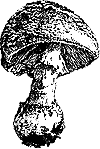 The Amanita muscaria mushroom is also known as "fly agaric" because
it attracts and kills flies. The Amanita muscaria
does not contain psilocybin or psilocin. Rather, the hallucinogenic
chemicals this mushroom contain are muscimol and ibotenic acid.
The Amanita muscaria mushroom is also known as "fly agaric" because
it attracts and kills flies. The Amanita muscaria
does not contain psilocybin or psilocin. Rather, the hallucinogenic
chemicals this mushroom contain are muscimol and ibotenic acid. The fly agaric is related to other deadly mushrooms: the Amanita virosa (the "Destroying Angel"); Amanita verna and Amanita phalloides (the "Death Cap"). These deadly mushrooms contain toxins that destroy cells in the liver and kidneys. Five to 24 hours after eating one of these toxic mushrooms people may become sick with nausea and stomach problems. Later, severe liver and kidney damage may occur. |
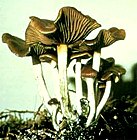 Psilocybe Mushroom 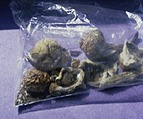 Psilocybe cubensis Photographs courtesy of the Indiana Prevention Center |
Effects on Behavior Psilocybin/Psilocin Mushrooms
Psilocybin/Psilocin MushroomsBoth psilocybin and psyilocin produce yawning, inability to concentrate, restlessness, increased heart rate, and hallucinations (visual and auditory). These symptoms may appear 30 to 60 minutes after the mushroom is eaten and can last about four hours.
Amanita muscaria |
Effects on the Nervous SystemThe chemical structure of psilocybin and psilocin is similar to the neurotransmitter called serotonin. In fact, the primary effect of psilocin is on the receptors for serotonin. There is also evidence that psilocybin reduces the reuptake of serotonin by neurons in the brain allowing this neurotransmitter more time to act in the synapse.
 Muscimol and ibotenic acid from the Amanita muscaria appear to act on the GABA neurotransmitter system. Muscimol activates GABA receptors on neurons. The GABA neurotransmitter system is one of the brain's major inhibitory systems. Therefore, muscimol acts to inhibit the activity of neurons in the brain. |
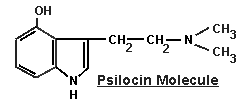
|
CAUTION | Picking and consuming mushrooms can be a dangerous activity! Identification of hallucinogenic mushrooms can be difficult because they look similar to toxic, deadly mushrooms. It is also possible that mushrooms bought from "street dealers" may be contaminated with drugs such as LSD or PCP. The images used on this web page are NOT meant to be used for mushroom identification purposes. |
| Did you
know? |
In 1998 in the United States, 9,839 cases of mushroom poisoning were reported by poison centers. Approximately 69% of these cases (6,796 cases) were children under the age of 6 years. (Statistic from Litovitz et al., Amer. J. Emerg. Medicine, 17:435-487, 1999.) |
They said it! | "All mushrooms are
edible,
but some only once." |
 For references and
more information about hallucinogenic mushrooms, see:
For references and
more information about hallucinogenic mushrooms, see:
|
| GO TO: | Alcohol | Amphetamines | Caffeine | Cocaine |
| Heroin | Inhalants | LSD | Marijuana | |
| Nicotine | Ecstasy | Rohypnol | 1,4-Butanediol | |
| GHB | Barbiturates | PCP | Hallucinogenic Mushrooms | |
| BACK TO: | Drug Effects
on the Nervous System |
Exploring the Nervous System | Table of Contents |
![[email]](./gif/menue.gif) Send E-mail |
 Get Newsletter |
 Search Pages |
 Donate to Neuroscience for Kids |